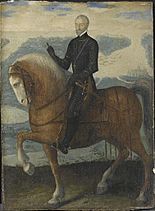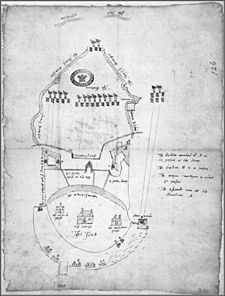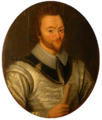Siege of Fort Crozon facts for kids
Quick facts for kids Siege of Fort Crozon |
|||||||
|---|---|---|---|---|---|---|---|
| Part of the Anglo–Spanish War and the French Wars of Religion |
|||||||
 Pointe des Espagnols – present day area where siege took place |
|||||||
|
|||||||
| Belligerents | |||||||
| Commanders and leaders | |||||||
| Strength | |||||||
10 ships & 1,200 sailors 300 cavalry & 400 knights |
4,000 (Relief) |
||||||
| Casualties and losses | |||||||
| 700 killed & wounded or sick & dead to disease | (Crozon) 400; only 13 survivors (relief) Unknown |
||||||
The Siege of Fort Crozon, also known as the Siege of El Leon, was an important battle fought on land and sea. It happened during the French Wars of Religion and the Anglo-Spanish War. This siege took place from October 1 to November 19, 1594.
English and French soldiers worked together to attack a Spanish fort. This fort was built on the Crozon Peninsula near Brest in France. The Spanish tried to send help, but it arrived too late. The English used a clever trick to finally win the battle.
This victory was very important for two reasons. First, it stopped Spain from having a major base in France. This base would have been used to attack England and the Netherlands. Second, it weakened Spain's allies in France. This allowed the French King Henry IV to declare war on Spain.
Contents
Why the Siege Happened
King Philip II of Spain wanted to create new naval bases in western France. These bases would help his navy threaten England and Ireland. In 1593, Spain built a base at Blavet. This worried England.
Reports then came that a Spanish force, led by Juan del Águila, wanted to capture the big port of Brest. John Norreys, an English commander already in France, warned Queen Elizabeth I. She saw the danger and ordered Norreys to team up with Martin Frobisher to remove the Spanish.
Building the Spanish Fort
The Spanish planned to attack Brest. As part of this plan, they built a strong fort on the Crozon Peninsula. This fort could control the entire Roadstead of Brest (the bay near Brest). Águila's main engineer, Captain Cristóbal de Rojas, designed a modern fort called El Leon.
Spanish Admiral Pedro de Zubiaur arrived with twelve ships. He brought equipment that helped build the fort faster. The fort had two strong bastions (parts of a fort that stick out) and a sloped area called a glacis. These protected the drawbridge where the peninsula met the mainland.
The fort had many cannons. One bastion had eighteen large cannons, and another smaller one had six. Many of these guns came from Zubiaur's fleet. Don Tomé de Paredes commanded the fort's garrison. His company, along with others, had 401 men. Their job was to finish building the fort. They built most of it in just 26 days.
Assembling the Allied Forces
In June, 1,000 experienced English soldiers arrived. They were led by Sir Thomas Baskerville and landed at Paimpol. In August, another 2,000 soldiers arrived from Plymouth. These were led by John Norreys.
Ten warships with 1,200 sailors and marines also joined. They were commanded by Martin Frobisher on his ship, the Vanguard. Fifty pioneers (workers who dig and build) from the tin miners of Cornwall were also with Norreys. These pioneers were skilled at digging mines under enemy forts.
The French forces were led by Jean VI d'Aumont. They included 3,000 soldiers under Baron de Molac. There were also 300 mounted soldiers with arquebuses (early firearms) and 400 knights. An army of local fighters was also gathered in Brest. They were led by René de Rieux, Lord of Sourdéac. However, this group did not take part in the siege itself.
Before reaching Crozon, the Anglo-French forces captured the town of Morlaix in September. They then took Quimper. In October, they moved towards Brest to begin the siege of the Crozon peninsula.
The Siege of Fort El Leon
The siege started on October 1. Frobisher's ships arrived first and blocked the fort from the sea. They fired some shots, even though the fort was not yet finished. The land army arrived soon after. On October 11, they began digging trenches. English ships also fired cannons from the sea to support them.
The attackers faced heavy fire from the Spanish cannons. They also had to deal with Spanish soldiers rushing out from the fort. These attacks, called sorties, happened day and night. This made it hard for the attackers to keep their positions.
Heavy Fighting Begins
Once the English and French set up their heavy cannons, they began firing continuously. This started to damage the fort. Soon after, the French attacked a bastion on the right side, and the English attacked on the left. The battle lasted three hours.
During the fight, a huge explosion happened behind the French attackers. Several large barrels of gunpowder blew up in one of the main French cannon positions. This might have been an accident or caused by a Spanish cannonball. Many French soldiers were killed or wounded, and they retreated in a panic.
There was a short break in the siege. The English and French needed more gunpowder, which had to come from Brest and the English ships. The Spanish used this time to finish their walls and repair the damaged bastions. At the same time, the Cornish pioneers continued trying to dig a mine under the fort.
On November 1, the Spanish launched a major sally (a sudden attack) against the enemy cannons. They surprised the attackers and reached a large French cannon position. They disabled three cannons and returned to the fort before the French could react. The Spanish caused heavy losses to the attackers while losing only eleven of their own men.
The Mine and Final Attack
The attackers' cannon fire slowed down a bit. Inside the fort, the Spanish were running low on gunpowder and ammunition. Paredes, the Spanish commander, sent a message asking Juan Aguila for help. Aguila decided to send a relief force, even though some disagreed.
Aguila's relief force was delayed because they didn't have cavalry. He continued with 4,000 soldiers and two cannons. A French cavalry force of 300 soldiers, armed with arquebuses, attacked Aguila's force many times. This delayed him even more.
Aumont, the French commander, heard about Aguila's approaching force. He ordered his soldiers to work harder. He especially pushed the miners to finish their tunnel and prepare for an immediate attack.
On November 17, the mine under the fort was finished and blown up. This caused huge damage to the fort's wall. About fifty Spanish soldiers were killed or injured. French and English cannons then fired, creating a large hole in the wall. The attack was ready for the next evening.
The English and French attack groups were prepared. The English were on the right, and the French were on the left. One English group was made up of sailors and marines, led by Martin Frobisher. They launched three large attacks into the breach. There was fierce fighting. A cannonball killed Paredes, the Spanish commander, as he defended his fort.
The attacks were stopped because there were rumors that Aguila's relief force had arrived. Martin Frobisher was among the many injured and was carried away. The rumors about Aguila were false. He was only four miles from the fort, planning to surprise the attackers the next day.
During the evening, the Spanish defenders heard that Aguila was close. This gave them hope, but they had very little ammunition left. Only one officer was still alive and unwounded.
The English Trick
The attackers decided on a desperate plan. At nightfall, an English officer approached the fort with a flag of truce. This was a trick. Behind him, in the darkness, Norreys's English soldiers quietly moved closer. They hoped to take advantage of the situation.
The trick worked. The English soldiers then rushed into the breach. This time, they overwhelmed the Spanish in fierce hand-to-hand combat. The Spanish fought bravely, but most of them were killed.
When Aguila heard that the fort had fallen, he was only a few miles away. He quickly retreated, leaving behind his heavy supplies and cannons. He feared falling into a trap.
After the Battle
The Anglo-French forces took control of the fort. The French criticized the English, especially Norreys, for being too harsh. Aumont ordered that any remaining Spanish survivors be treated as prisoners of war.
Out of 400 Spanish soldiers, only thirteen survived. Nine soldiers managed to hide among the dead and were taken prisoner. Four others escaped to the rocks near the sea. A French Navy commander, Christophe-Paulin de La Poix de Fréminville, later said that this event showed the different natures of each nation.
The English and French lost about 700 men. This included those killed in battle or who died from disease. Most of the casualties in the actual fighting were French. French Marshal Liscoet and Lord Romegon died in the breach. Frobisher died from his wound after returning to Plymouth, because gangrene (a serious infection) had set in.
Sourdéac's local fighters arrived soon after the battle. They immediately began to completely destroy the fort until nothing was left. Norreys then tried to find Aguila's remaining troops, but Aguila retreated further away. The Duke of Mercœur, a French ally of Spain, was furious about the defeat. He threatened to attack Aumont and take Brest himself.
The Spanish soldiers' bravery was admired by their enemies. Paredes, the Spanish commander, was buried in the Church of Brest with full military honors. The Spanish prisoners were later released and sent back to Aguila. Aumont praised their bravery in letters he gave them.
In November, three captured Spanish flags from the campaign were given to Queen Elizabeth I. Norreys was celebrated as a hero. English troops left France in February of the next year. Elizabeth could then send her soldiers back to the Netherlands.
The Spanish still held their base at Blavet. This allowed them to launch a small attack on Cornwall the next year. This attack showed that England's defenses needed improvement.
For Spain, the defeat at Crozon was a disaster. It ended their hopes of using Brest to invade England. It also hurt King Philip II's plans for his navy. Support for Spain's French allies quickly faded after this defeat. Tensions grew between the Spanish forces and their allies. Taking advantage of this, the French King Henry IV declared war on Spain on January 17, 1595. This war lasted until the Peace of Vervins was signed three years later.
Important People from the Siege
Both Samuel de Champlain and Martin Frobisher were at this siege. They were two early explorers of Canada. It is likely they met and knew each other here.
Soon after the fort was destroyed, the French named the place Pointe des Espagnols (Spanish Point). This was to honor the courage of the Spanish defenders.
Images for kids












